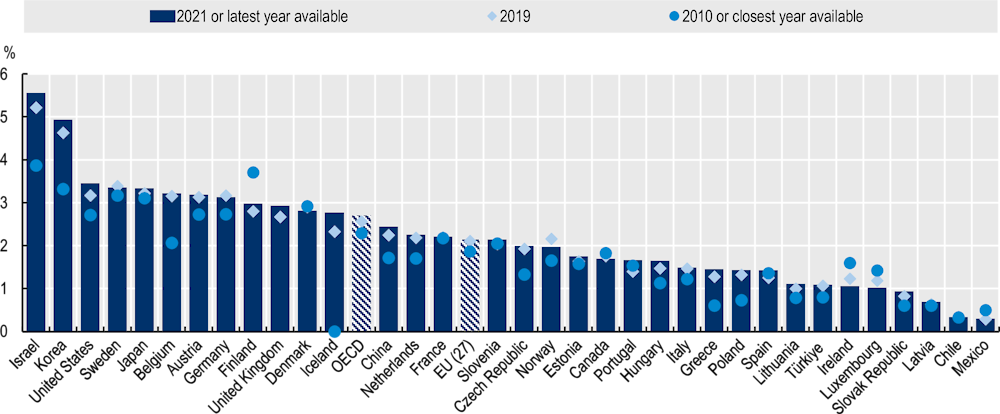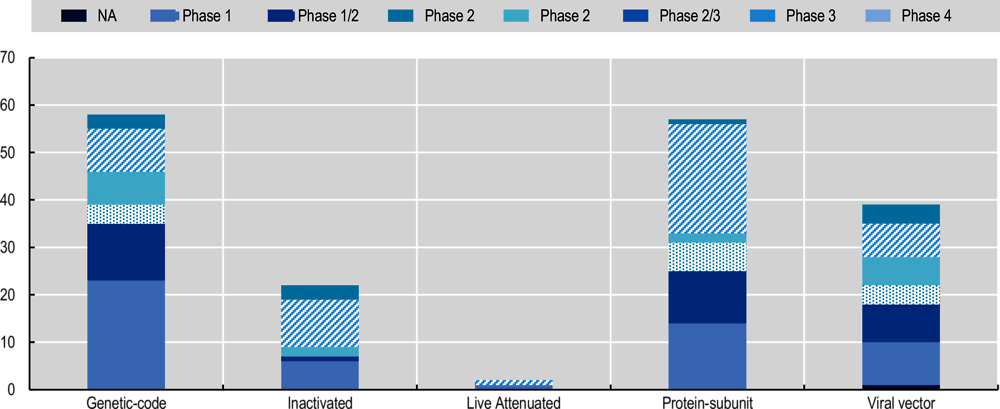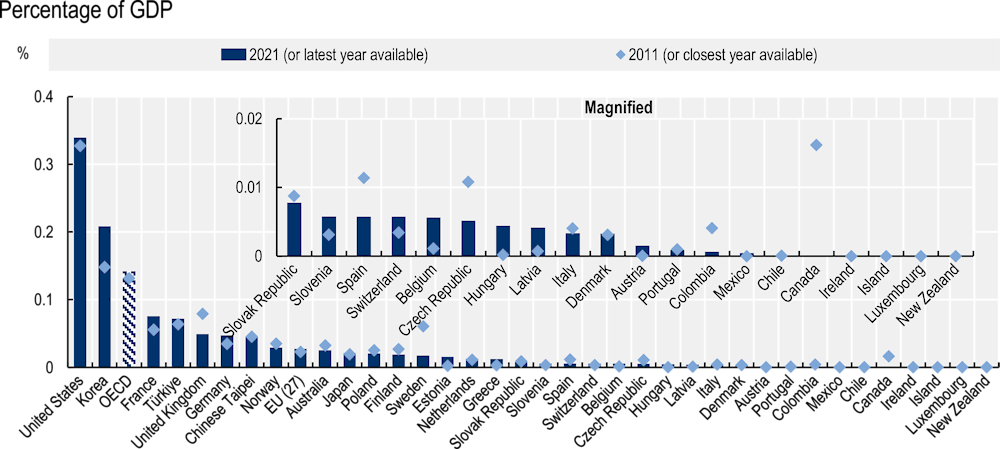[52] Adepoju, P. (2022), “African coronavirus surveillance network provides early warning for world”, Nature Biotechnology, Vol. 40/2, pp. 147-148, https://doi.org/10.1038/d41587-022-00003-3.
[37] Bakerlee, C. (2021), Mother Nature is not ‘the ultimate bioterrorist’, STAT, https://www.statnews.com/2021/01/08/mother-nature-is-not-the-ultimate-bioterrorist/ (accessed on 24 February 2023).
[4] Barreneche, A. (2021), Tracking science and innovation policies in response to COVID-19, https://stiplab.github.io/datastories/covid/covid_blog.html (accessed on 24 February 2023).
[38] Bell, J. and J. Nuzzo (2021), Global Health Security Index: Advancing Collective Action and Accountability Amid Global Crisis, Global Health Security Index, https://www.ghsindex.org/wp-content/uploads/2021/12/2021_GHSindexFullReport_Final.pdf (accessed on 24 February 2023).
[51] Biasin, M. et al. (2021), “UV-C irradiation is highly effective in inactivating SARS-CoV-2 replication”, Scientific Reports, Vol. 11/1, https://doi.org/10.1038/s41598-021-85425-w.
[31] Council, I. (2022), Conference on the Ukraine Crisis: Responses from the European higher education and research sectors, https://doi.org/10.24948/2022.04.
[48] de Silva, M. et al. (2022), “How did COVID-19 shape co-creation?: Insights and policy lessons from international initiatives”, OECD Science, Technology and Industry Policy Papers, No. 134, OECD Publishing, Paris, https://doi.org/10.1787/e11c5274-en.
[35] DeLisi, C. (2019), “The role of synthetic biology in climate change mitigation”, Biology Direct, Vol. 14/1, https://doi.org/10.1186/s13062-019-0247-8.
[46] European Commission (2022), “Tackling R&I foreign interference: staff working document”, https://op.europa.eu/en/publication-detail/-/publication/3faf52e8-79a2-11ec-9136-01aa75ed71a1/language-en (accessed on 24 February 2023).
[45] G7-Summit (2022), Annex to the G7 Science Ministers` Communiqué 2022: Further Implementation and G7 Science Working Groups, https://www.bmbf.de/SharedDocs/Downloads/de/2022/220613-g7-annex.pdf?__blob=publicationFile&v=4 (accessed on 24 February 2023).
[26] Gaind, N. et al. (2022), “Seven ways the war in Ukraine is changing global science”, Nature, Vol. 607/7919, pp. 440-443, https://doi.org/10.1038/d41586-022-01960-0.
[43] Herfst, S. et al. (2012), “Airborne Transmission of Influenza A/H5N1 Virus Between Ferrets”, Science, Vol. 336/6088, pp. 1534-1541, https://doi.org/10.1126/science.1213362.
[47] Homer-Dixon, T. et al. (2022), “A call for an international research program on the risk of a global polycrisis”, https://cascadeinstitute.org/technical-paper/a-call-for-an-international-research-program-on-the-risk-of-a-global-polycrisis/ (accessed on 24 February 2023).
[23] Hudson, R. (2022), US to ‘wind down’ research collaboration with Russia, Science|Business, https://sciencebusiness.net/news/us-wind-down-research-collaboration-russia (accessed 4 October 2022). (accessed on 24 February 2023).
[24] Hudson, R. et al. (2022), “The conduct of science in times of war”, Science Business discussion paper, Science|Business, https://sciencebusiness.net/report/conduct-science-times-war (accessed 4 October 2022).
[9] International Science Council (2022), Conference on the Ukraine Crisis: Responses from the European higher education and research sectors - A Conference Report, International Science Council, https://doi.org/10.24948/2022.04.
[16] International Science Council (2022), Unprecedented & Unfinished: COVID-19 and Implications for National and Global Policy, International Science Council, https://doi.org/10.24948/2022.03.
[10] Johnson Sirleaf, E. and H. Clark (2022), Transforming or Tinkering? Inaction lays the groundwork for another pandemic.
[33] Khan, A. et al. (2022), “Combating Infectious Diseases with Synthetic Biology”, ACS Synthetic Biology, Vol. 11/2, pp. 528-537, https://doi.org/10.1021/acssynbio.1c00576.
[14] Kozlov, M. (2022), “Why scientists are racing to develop more COVID antivirals”, Nature, Vol. 601/7894, pp. 496-496, https://doi.org/10.1038/d41586-022-00112-8.
[11] Ledford, H. (2022), “COVID vaccine hoarding might have cost more than a million lives”, Nature, https://doi.org/10.1038/d41586-022-03529-3.
[12] Ledford, H. (2022), “Donated COVID drugs start flowing to poor nations — but can’t meet demand”, Nature, https://doi.org/10.1038/d41586-022-02939-7.
[13] Mallapaty, S. (2022), “Japan’s $2-billion initiative to prep pandemic vaccines in 100 days”, Nature, Vol. 610/7930, pp. 20-20, https://doi.org/10.1038/d41586-022-03000-3.
[34] Mudziwapasi, R. et al. (2022), “Unlocking the potential of synthetic biology for improving livelihoods in sub-Saharan Africa”, All Life, Vol. 15/1, pp. 1-12, https://doi.org/10.1080/26895293.2021.2014986.
[29] Nature (2022), “Ukraine’s scientists need help to rebuild their research system”, Nature, Vol. 609/7925, pp. 7-7, https://doi.org/10.1038/d41586-022-02760-2.
[15] Nelson, F. (2022), “Billion-dollar project aims to prep drugs before the next pandemic”, Nature, https://doi.org/10.1038/d41586-022-02776-8.
[54] OECD (2022), “Building back a better innovation ecosystem in Ukraine”, OECD Policy Responses on the Impacts of the War in Ukraine, OECD Publishing, Paris, https://www.oecd.org/ukraine-hub/policy-responses/building-back-a-better-innovation-ecosystem-in-ukraine-85a624f6/ (accessed on 6 March 2023).
[44] OECD (2022), “Integrity and security in the global research ecosystem”, OECD Science, Technology and Industry Policy Papers, No. 130, OECD Publishing, Paris, https://doi.org/10.1787/1c416f43-en.
[32] OECD (2022), OECD Economic Outlook, Volume 2022 Issue 1, OECD Publishing, Paris, https://doi.org/10.1787/62d0ca31-en.
[1] OECD (2022), OECD Economic Outlook, Volume 2022 Issue 2, OECD Publishing, Paris, https://doi.org/10.1787/f6da2159-en.
[3] OECD (2022), OECD Main Science and Technology Indicators: Highlights – March 2022, https://www.oecd.org/sti/msti-highlights-march-2022.pdf (accessed on 24 February 2023).
[21] OECD (2022), Public communication and engagement in science: lessons learned from COVID-19, https://www.oecd.org/sti/inno/public-communication-engagement-in-science.htm (accessed on 24 February 2023).
[30] OECD (2022), “The future of science in Ukraine: Actions now will affect post-war recovery”, OECD Policy Responses on the Impacts of the War in Ukraine, OECD Publishing, Paris, https://doi.org/10.1787/afbd05df-en.
[2] OECD (2021), OECD Science, Technology and Innovation Outlook 2021: Times of Crisis and Opportunity, OECD Publishing, Paris, https://doi.org/10.1787/75f79015-en.
[36] OECD (forthcoming), “Existential risks in synthetic biology: considerations and scenarios”.
[6] OECD (forthcoming), Measuring governments’ R&D funding response to COVID-19 with project data: Preliminary analysis from the OECD Fundstat initiative.
[27] Owens, B. (2022), “Energy crisis squeezes science at CERN and other major facilities”, Nature, Vol. 610/7932, pp. 431-432, https://doi.org/10.1038/d41586-022-03257-8.
[22] Pierri, F. et al. (2022), “Online misinformation is linked to early COVID-19 vaccination hesitancy and refusal”, Scientific Reports, Vol. 12/1, https://doi.org/10.1038/s41598-022-10070-w.
[39] Rabitz, F. (2014), Regulatory Gaps in the Global Governance of Synthetic Biology.
[41] Sandbrink, J. et al. (2022), “Mitigating Biosecurity Challenges Associated with Zoonotic Risk Prediction”, SSRN Electronic Journal, https://doi.org/10.2139/ssrn.4035760.
[42] SpillOver (2022), SpillOver: Viral Risk Ranking, https://spillover.global (accessed on 24 February 2023).
[49] Sun, T. et al. (2022), “Challenges and recent progress in the governance of biosecurity risks in the era of synthetic biology”, Journal of Biosafety and Biosecurity, Vol. 4/1, pp. 59-67, https://doi.org/10.1016/j.jobb.2022.02.002.
[50] Thompson, T. (2021), “Real-world data show that filters clean COVID-causing virus from air”, Nature, https://doi.org/10.1038/d41586-021-02669-2.
[19] UKCDR and GloPID-R (2023), Indirect health impacts, https://www.ukcdr.org.uk/wp-content/uploads/2022/07/2-Tracker-Highlights-Template_Indirect-health-impacts.pdf (accessed on 24 February 2023).
[20] UKCDR and GloPID-R (2022), Long COVID, https://www.ukcdr.org.uk/wp-content/uploads/2022/09/UKCDR-140922-Tracker-Highlights-Long-Covid.pdf (accessed on 24 February 2023).
[17] UKCDR and GloPID-R (2022), New variants, https://www.ukcdr.org.uk/wp-content/uploads/2022/09/UKCDR-140922_new-variants.pdf (accessed on 24 February 2023).
[18] UKCDR and GloPID-R (2022), Research Capacity Strengthening, https://www.ukcdr.org.uk/wp-content/uploads/2022/09/UKCDR_140922_Research-Capacity-Strengthening.pdf (accessed on 24 February 2023).
[25] Undseth, M. and C. Jolly (2022), “A new landscape for space applications: Illustrations from Russia’s war of aggression against Ukraine”, OECD Science, Technology and Industry Policy Papers, No. 137, OECD Publishing, Paris, https://doi.org/10.1787/866856be-en.
[53] Waltz, E. (2022), “How nasal-spray vaccines could change the pandemic”, Nature, Vol. 609/7926, pp. 240-242, https://doi.org/10.1038/d41586-022-02824-3.
[7] Watson, O. et al. (2022), “Global impact of the first year of COVID-19 vaccination: a mathematical modelling study”, The Lancet Infectious Diseases, Vol. 22/9, pp. 1293-1302, https://doi.org/10.1016/s1473-3099(22)00320-6.
[5] WHO, W. (2020), “A Coordinated Global Research Roadmap: 2019 Novel Coronavirus”.
[8] Wilson Center (2022), Reframing Vaccine Diplomacy Amid Strategic Competition: Lessons from COVID-19.
[40] Xie, X. et al. (2021), “Engineering SARS-CoV-2 using a reverse genetic system”, Nature Protocols, Vol. 16/3, pp. 1761-1784, https://doi.org/10.1038/s41596-021-00491-8.
[28] Zubașcu, F. (2022), Energy crisis is starting to hit Europe’s big science labs, Science|Business, https://sciencebusiness.net/news/energy-crisis-starting-hit-europes-big-science-labs (accessed on 24 February 2023).














